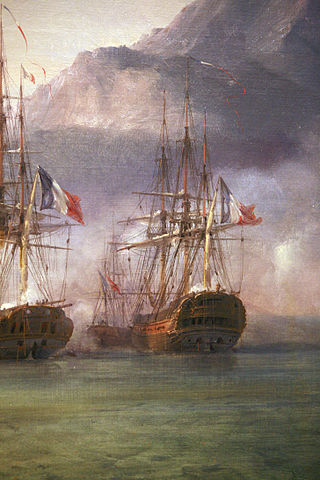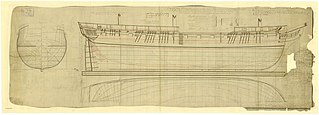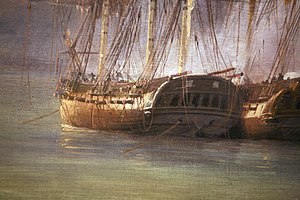
HMS Fantome was an 18-gun brig-sloop of the Royal Navy. She was originally a French privateer brig named Fantôme, which the British captured in 1810 and commissioned into British service. Fantome saw extensive action in the War of 1812 until she was lost in a shipwreck at Prospect, Nova Scotia, near Halifax in 1814.

HMS Belvidera was a Royal Navy 36-gun Apollo-class frigate built in Deptford in 1809. She saw action in the Napoleonic Wars and the War of 1812 and continued a busy career at sea into the middle of the 19th century. In 1846 she was reduced to harbour service, in 1860 she became a receiving ship, and she was finally disposed of in 1906.
HMS Niemen was a Royal Navy 38-gun fifth-rate frigate. She began her career as the Niémen, a 44-gun French Navy Armide-class frigate, designed by Pierre Rolland. She was only in French service for a few months when in 1809 she encountered some British frigates. The British captured her and she continued in British service as Niemen. In British service she cruised in the Atlantic and North American waters, taking numerous small American prizes, some privateers but mostly merchantmen. She was broken up in 1815, at the end of the Napoleonic Wars and the War of 1812.

Furieuse was a 38-gun frigate of the French Navy. The Royal Navy captured her in 1809 and took her into service as the fifth rate HMS Furieuse. She spent most of her British career in the Mediterranean Sea, though towards the end of the War of 1812 she served briefly on the North American station. She was laid up in 1815 and sold for breaking up in 1816.

Revenant was a 20-gun privateer corvette, launched in 1807, and designed by Robert Surcouf for commerce raiding. The French Navy later requisitioned her and renamed her Iéna, after Napoleon's then-recent victory at the Battle of Jena–Auerstedt. The British captured her in 1808 and she served in the Royal Navy as HMS Victor. The French Navy recaptured her in 1809, taking her back into service under the new name. The British again captured her when they took Isle de France in December 1810. They did not restore her to service and she was subsequently broken up.

HMS Epervier was an 18-gun Cruizer-class brig-sloop of the Royal Navy, built by Ross at Rochester, England, and launched on 2 December 1812. USS Peacock captured her in 1814 and took her into service. USS Epervier disappeared in 1815 while carrying dispatches reporting the signing of a treaty with the Dey of Algiers.

Armide was a 40-gun frigate of the French Navy, lead ship of her class, and launched in 1804 at Rochefort. She served briefly in the French Navy before the Royal Navy captured her in 1806. She went on to serve in the Royal Navy until 1815 when she was broken up.

HMS Mosquidobit was the Chesapeake-built six-gun schooner Lynx that the British Royal Navy captured and took into service in 1813. She was sold into commercial service in 1820 and nothing is known of her subsequent fate.
HMS Landrail was a Cuckoo-class schooner built by Thomas Sutton at Ringmore, Teignmouth. Like all her class she carried four 12-pounder carronades and had a crew of 20. She had a relatively uneventful career during the Napoleonic Wars and the War of 1812 until 1814 when she was taken in a notable action, and then retaken. She was sold in approximately 1818.
HMS Shelburne was the American letter of marque schooner Racer, built in Baltimore in 1811 and captured by the British in 1813. She served on the American coast, capturing the American brig Frolic. She also captured some merchantmen and was sold in Britain in 1817.
HMS Laura was an Adonis-class schooner of the Royal Navy, launched in 1806 at Bermuda. Laura served during the Napoleonic Wars before a French privateer captured her at the beginning of the War of 1812. She was briefly an American letter of marque before the British recaptured her in 1813. Despite having recaptured her, the British did not return Laura to service.
HMS Colibri was the French naval Curieux-class brig Colibri, launched in 1808, that the British captured in 1809 and took into the Royal Navy under her existing name. She spent her time in British service on the North American station based in Halifax, Nova Scotia. During the War of 1812, Colibri served mostly in blockading the American coast and capturing privateers and merchant ships. She foundered in 1813 in Port Royal Sound, South Carolina, but without loss of life.
HMS Canso was the American letter of marque schooner Lottery, launched in 1811, that a British squadron captured in 1813. The Royal Navy took Lottery into service as HMS Canso and she served during the War of 1812 and briefly thereafter. The navy sold her in 1816.

HMS Grasshopper was a Cruizer-class brig-sloop of the Royal Navy. She was launched in 1806, captured several vessels, and took part in two notable actions before the Dutch captured her in 1811. She then served The Netherlands navy until she was broken up in 1822.
The French brig Observateur, which was launched in 1800 for the French Navy, was a Vigilant-class 16-gun brig, one of six built to a design by Pierre-Alexandre-Laurent Forfait. The Royal Navy captured her in 1806 and took her into service as HMS Observateur. She participated in two actions, one for the French Navy and one for the Royal Navy, and one campaign before she was laid up in 1810. The Navy did not succeed in selling her until 1814.
HMS Magnet was an American brig captured in 1812. HMS Magnet served during the War of 1812 as a prison ship at Halifax, Nova Scotia. The Royal Navy eventually renamed her Attentive, possibly in 1814 when the Navy acquired Sir Sydney Smith, which it renamed Magnet. Then as Attentive she served as a store ship, still apparently on the Halifax station, before she sailed to Britain in 1816. She was broken up in January 1817.
HMS Acteon, was the brig Actéon, launched in France in 1804 as the second of the two-ship Lynx-class. The British Royal Navy captured her in 1805 but laid her up. The Navy finally commissioned her in 1809. She was at the British invasion of Île de France and later served in the Channel, the North Sea, the Baltic, and the Chesapeake. She was broken up in 1816.

HMS Barrosa was launched in 1812 for the Royal Navy and served during the War of 1812 during which she captured several prices. After the war she spent a decade or so (1823–1833) on harbour duties. The navy sold Barrosa in 1841.
HMS Martin was launched in Bermuda in 1809. Commander John Evans then commissioned her at Halifax Nova Scotia. During the War of 1812, Martin spent much of her time on the Halifax station. She captured or shared in the capture of numerous small merchant vessels. She also captured a small United States privateer, and was involved in an action with United States gunboats. After the war she conducted patrols against smugglers. She was on one of those patrols when she was wrecked in 1817.

HMS Dover was a 38-gun troopship, previously the French corvette Bellona, launched at Venice in 1808. She was captured at Lissa in 1811. She served as a troopship and transport until circa 1819. She then became the flagship for the Admiral commanding the Leith station. She was used for harbour service from 1825, and was sold in 1836.










